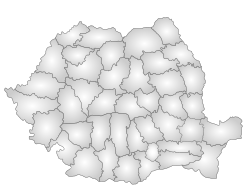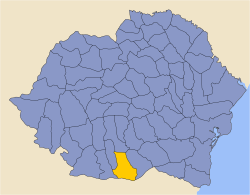|
Teleorman County
Teleorman County (Romanian pronunciation: [ˈtele.orman]) is a county (județ) of Romania on the border with Bulgaria, in the historical region Muntenia, with its capital city at Alexandria. The name Teleorman is of Cumanic (Turkic) origin. It literally means wild/crazy forest (modern Turkish, Deli orman) and, by extension, "thick and shadowy forest" in the Cuman language.[3] It can be encountered in other toponyms, such as the Turkish name of the Ludogorie Plateau in northeastern Bulgaria, Deliorman. DemographicsIn 2021, the county had a population of 323,544 and the population density was 55.88/km2 (144.73/sq mi).
GeographyTeleorman County has a total area of 5,790 square kilometres (2,240 sq mi). Two distinctive elements can be found:
Beside the Danube, the main river crossing the county is the Olt River which flows into the Danube close to the village of Islaz. Other important rivers are: the Vedea River, the Teleorman River, and the Călmățui River. Neighbours
EconomyThe predominant industries in the county are:
Agriculture is the main occupation in the county. Both extensive agriculture, and small scale — vegetables and fruits for the Bucharest markets — is practiced. The area is well suited for irrigations. Tourism The county doesn't have many spectacular attractions, but its cultural folk heritage is very rich. Many Romanian personalities have been born here, some of them later describing the life in a village in a very picturesque way. Also, the area was one of the places where the Wallachian Revolution of 1848 unfolded. The main tourist destinations are:
PoliticsThe Teleorman County Council, renewed at the 2020 local elections, consists of 32 counsellors, with the following party composition:[6]
Administrative divisions   Teleorman County has 3 municipalities, 2 towns and 92 communes
PeopleNatives of Teleorman County include: Historical county
Historically, the county was located in the southern part of Greater Romania, in the southwestern part of the historical region of Muntenia. Its capital was Turnu Măgurele. The county was bordered on the west by the counties Romanați County and Olt County, to the north by Argeș County, to the east by Vlașca County, and in the south across the Danube River by the Kingdom of Bulgaria. Its territory coincides in large part with that of the present county. Administration The county was originally divided into five administrative districts (plăși):[7]
Subsequently, the county established three more districts:
The county contained four urban communes: Turnu Măgurele, Alexandria, Roșiorii de Vede, and Zimnicea. PopulationAccording to the 1930 census data, the county population was 347,294 inhabitants, ethnically divided as follows: 98.1% Romanians, 1.4% Romanies, as well as other minorities. From the religious point of view, the population was 99.0% Eastern Orthodox, 0.6% Adventist, 0.1% Muslim, as well as other minorities. Urban populationIn 1930, the county's urban population was 58,632 inhabitants, comprising 94.4% Romanians, 3.3% Romanies, 0.4% Hungarians, 0.4% Jews, as well as other minorities. From the religious point of view, the urban population was composed of 98.1% Eastern Orthodox, 0.6% Muslim, 0.4% Jewish, 0.4% Roman Catholic, as well as other minorities. ReferencesWikimedia Commons has media related to Teleorman County.
External links |
||||||||||||||||||||||||||||||||||||||||||||||||||||||||||||||||||||||||||||||||||||||||||||||||||||||||||||||||||||||||||||||||||||||||||||||||||||||||||






